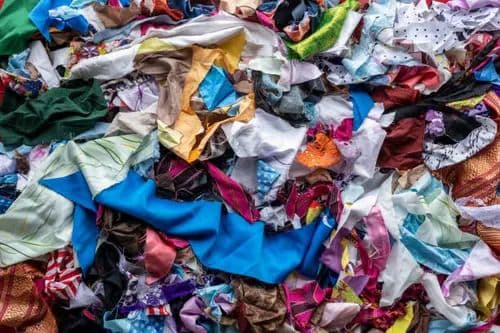Sustainability for Fashion Brands
4 mins read
Zero Waste Fashion: An Essential Guide for African Creatives to Reduce Textile Waste
By Joy Oshiokenoya
June 3, 2025
Fabric scraps piled in rice sacks. That’s a memory many African creatives share and a symbol of fashion waste hiding in plain sight. This essential guide explores how African fashion designers can embrace zero waste practices to reduce textile waste, from innovative pattern-making to modular design and digital tools. Learn practical strategies and see how brands like Bola Yahaya and Akna are already leading the way toward a more sustainable fashion future on the continent.

Fabric off-cuts Image source: iStock
When I was a child, there was a tailor’s shop a few blocks from my house. Next to it stood an empty stall that soon became a favourite play area for me and my friends.
Sometimes, we’d play make-believe, imagining ourselves as stylish mums or CEOs who had it all figured out, strutting around in makeshift heels made by attaching stones to our flat slippers.
Other times, we did my all-time favourite activity – making dresses for our dolls. We’d use fabric scraps found in empty rice sacks beside the tailor’s stall.
At the time, I didn’t think much of those fabric scraps. But looking back, I realise they were a part of a much bigger problem in fashion.
Those empty rice sacks filled with fabric scraps weren’t unique to her shop. They were everywhere. Nearly every tailor shop I saw had at least two or three of them stacked outside, waiting for disposal.
Ultimately, those scraps end up in landfills or are burned, releasing harmful toxins into the atmosphere.
Over a decade has passed, yet fashion waste remains an unsolved problem. Clothing and textile waste currently accounts for at least 7% of the total amount of waste in global landfill space. One would think that with all the advancements in sustainability, we’d have found better ways to manage it. But a quick look around proves otherwise. Fashion shops still produce massive amounts of waste, and most of it still ends up in the same landfills or, worse, is burned.
Just the other day on TikTok, I came across a video showing huge piles of off-cuts from one month of production at the SMEDAN garment hub.
As we become more aware of the environmental impact of fashion waste, the real question isn’t just about acknowledging the problem. It’s about action.
How can fashion designers or fashion brands move toward zero waste? I offer three practical strategies to get started.
Before we dive, what really is zero waste fashion?
What is Zero Waste Fashion?
Zero waste fashion is about designing and producing clothes without creating textile waste. Statistics show that about 15% of the fabric used by the fashion industry is discarded during the cutting process.
To counteract these wasteful practices, zero waste fashion has emerged as a sustainable design approach that focuses on reducing waste through smart design, innovation, and intention.
It achieves this in the following way;
Innovative pattern-making
In zero waste design, patterns are drafted in such a way that no fabric is wasted during the cutting phase. It involves creating patterns with intricate designs and geometric shapes that utilise the entire width of the fabric.
It often also involves strategic cutting designed to fit the width of the fabric and draping techniques. The result is a garment with all its pieces fitting together like a jigsaw puzzle, with minimal to no waste involved.
The sustainable fashion brand Bola Yahaya, based in Nigeria, is a strong example of true zero-waste fashion. The brand uses innovative pattern cutting and draping techniques to eliminate fabric waste right from the design stage.
Modular and versatile design
Modular garments are clothing items that can be assembled and disassembled into multiple parts without having to sew individual parts together. Instead, different parts like the sleeves or collars can be zipped or buttoned onto the main body. This not only minimises waste but also allows for customisation, reuse and repair.
This design system also allows garments to be styled in various ways, thereby maximising use and reducing the need for multiple items.
Check out Akna’s PHLUID collection for a real example of modular zero-waste fashion in action.
Digital tools
This involves utilising digital tools like CAD (Computer-Aided Design) software to help designers plan and maximise fabric use digitally before cutting the actual material. It is also especially useful for small brands that can’t afford large-scale sampling.
Zero waste fashion is exactly what the African fashion industry needs to stay bold, relevant, and forward-thinking in the sustainability space. By embracing these approaches, designers can reduce waste and lead the change towards a more conscious fashion future.
Are you a fashion creative already exploring zero waste methods? Share your process and tag us with #threaditzerowaste.
Like Post
Comments
No comments yet. Be the first to comment!
Related Posts
MoreRita Idehai, on Waste, Work, and Driving Social Impact in Nigeria
Through Ecobarter and its fashion arm, Wrep, Rita Idehai is transforming plastic waste into fabric, and creating new pathways for women and communities to thrive.
Miss Green Fashion ‘25: Celebrating Beauty, Sustainability, and Impact
Miss Green Fashion is redefining beauty with purpose, promoting sustainability, creativity, and women’s empowerment.
10 Sustainable Fashion Habits You Can Start Today
We highlight 10 simple everyday habits to make your fashion choices more sustainable, from rewearing and repairing to thrifting and supporting local artisans.
The Hidden Plastics in Our Clothes
Much of our clothing is made from plastic-based fabrics like polyester and nylon. Learn their impact and how to choose more sustainable options.